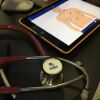The history of respiratory monitoring devices is pretty brief. First we had almost nothing; now we have more than we really understand how to use. That is a pretty big sea change in only 20 years. For most of my EMS career, respiratory monitoring has been pretty basic, and so have the tools.
“Look, Listen, and Feel” were ingrained into all our heads. The stethoscope was the first tool we had for monitoring the respiratory system, and it is still one of the best. It will allow you to hear a lot, if you are properly trained what to listen for.
The stethoscope itself has a long history, going back to the Greek’s use of a chest trumpet. The modern, easily recognizable binaural stethoscope actually dates to the 1870s. In the 1940s, Rappaport and Sprague designed a leading stethoscope, followed by Dr. David Littmann and Littmann stethoscopes in the 1960s and 1970s.
Today’s stethoscope ranges from inexpensive, basic industrial Sprague models to fine crafted instruments like the Littmann Classic II SE from 3M and the Puretone from Trimline, now part of WelchAllyn. Some like the wild colors and single-sided head of the UltraScope.
When it comes to good EMS stethoscopes, we have a few special requirements. I suggest you resist your built-in love of pretty and shiny, at least when it comes to the best stethoscopes. The better heads are machined or drop forged from solid steel and aluminum. Basic vinyl tubing looks and works great when new, but has a few drawbacks over time. Better tubing is more resistant to UV and chemicals.
EMS providers work outside. We need something built to take the rigors of our work environment. We see a lot of the outdoors. Frankly, I usually say the thicker the tubing the better, but this is not always true. In recent years, I’ve even seen high-grade tubing with a woven steel liner. I also like shorter scopes, and tend to pack them rather than wear them. One guy swinging from it tied around your neck will convince you, too.
But the truth is what is best for you is what you like the best. I do advise you to invest a little extra in two basic work tools of the EMT and paramedic — a great stethoscope and a great pair of boots. Both will prove to be dividend-paying investments in yourself long term.
The next generation in stethoscopes are electronic amplified models like the Littmann 3200 Electronic Stethoscope with Ambient Noise Reduction and WelchAllyn Elite. These have evolved rapidly, and today can even provide Bluetooth transmission of respiratory sounds to your destination ER. At least, they have that potential.
This brings up another great basic respiratory monitoring device — the esophageal stethoscope. This basic, simple and widely available disposable device puts your ear right inside the patient. They range from basic models to those that also monitor core temperature, with the right externals.
A typical esophageal stethoscope is pretty simple. They look like a nasogastic catheter, with the distal end closed and the other end hooked to an earpiece. You lubricate the closed end, no bigger than a thin NG tube, and send it down the nose and into the esophagus. Ideally, the tip is placed near the heart and lungs. Stick the other end in your ear and prepare yourself for a surprise.
You can hear every heartbeat, every taken or artificially delivered breath. It does not matter if you drive over a series of railroad tracks; you will still hear everything. It is because you are listening from the inside, plus have the torso to insulate out most of the road noise. Anesthesiologists used these things for years. Before the disposable esophageal stethoscope with disposable earpieces, anesthesiologists often had expensive custom molded earpieces made.
In more recent years, electronics have dominated the monitoring scene. We first had the pulse oximeter. The earliest models were cumbersome, but then in the 80s Nonin built a hand-held pulse oximeter that would hold up on the street. In later years, BCI made the market bigger with a value priced hand-held pulse oximeter.
These days, pulse oximeters have decreased in size from hand-held models to small, multiuse fingertip oximeters. SAO2 changed from something you checked on a respiratory distress patient, to practically a fifth vital sign in only 20 years.
Pulse oximeters give you basic heart rate and SAO2, but they don’t tell you respiratory rate or much else. For that you need a separate device or, often, as a feature in a multi-parameter monitor. They basically measure minute changes in air pressure with a small transducer hooked to a special nasal cannula.
The next frontier in respiratory monitoring was capnography. Capnography is still largely underestimated in its full potential to impact EMS. At first, it was used on mostly arrest patients to confirm ET tube placement. The earliest models were simple carbon dioxide detectors, some even disposable.
Then we began to appreciate the immediacy of capnography and its ability to quickly respond to changes in condition, or even better, monitor the effectiveness of a given respiratory therapy. New models from companies like Nelcor, BCI, Nonin, and Oridion have the potential to help us better detect and trend changes in respiratory physiology earlier than ever before.
The next generation of respiratory monitoring is likely to come in the form of new, non-invasive technologies. Several firms have working models developed of small devices, which non-invasively read thoracic movement. Others read changes in electrical current across the thorax. The future of cool respiratory monitoring gadgets is bright. Let’s just never forget to check our patient first, and “Look, Listen, and Feel.”


